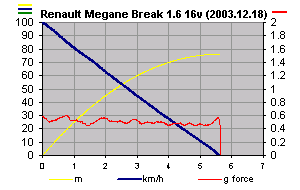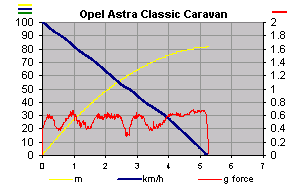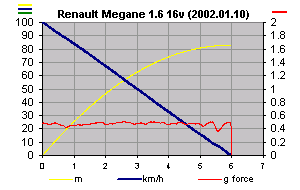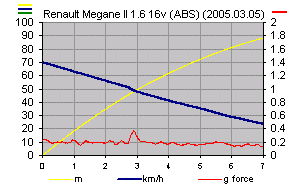Like
0-100 km/h braking from 100 km/h (62 mph) to a halt is a popular performance indicator.
When we do this test, we accelerate to about 110 km/h and brake from there,
then display the data from the point where speed reaches 100 km/h.
Let's see what have we got.
The
list is ordered by the measured braking distance, best on top.
Click on the small charts to see them in detail.
(note:
this part of the website is static html at the moment, so there's no automatic
unit conversion.)
|
Volvo S70 T5 (driver only) 2007. April 21. | |
|
At least, we have a new top result. The car has ABS of course, it's quite heavy,
almost 1500kg without driver. |
![]()
|
Honda Civic Type-R (2 people
on board) 2003. April 13. | |
|
We logged this run in nice, warm weather on dry tarmac.
As I was on board during the test as a passanger, I can testify deceleration was
intense. |
![]()
|
VW Passat TDI (ABS) (driver only) 2004. October 9. | |
|
Summer tires in good weather, but on cold tarmac. |
![]()
|
Opel Astra Classic 1.4 16v (ABS) (driver
only) 2002. September 2. | |
|
Deceleration just about touches 1g at some point, but it
averages around 0.85 g. |
![]()
|
Opel Astra Classic 1.6 16v (100 Le) (driver
only) 2001. December 21. | |
|
Without ABS, on dry tarmac, cold weather, around 0 °C.
Kléber Krisalp 3 185/60R14 winter tires |
![]()
|
Subaru Impreza WRX (ABS) (2 people
on board) 2001. December 26. | |
|
ABS, dry road, 17"-os winter tires. Temperatures around
0 °C. |
![]()
|
Opel Astra Classic Caravan 1.4 (60Le) (driver
only) 2001. December 8. | |
|
No ABS, dry roads, Pirelli 175/70R13 winter tires. About
0 °C. |
![]()
|
Subaru Impreza WRX (no ABS!) (2
people on board) 2001. December 26. | |
| ABS disengaged, dry road,
17"-os winter tires. Temperatures around 0 °C. |
![]()
|
BMW E46 320i (driver only) 2002. March 22. | |
| With ABS, damp tarmac, summer tires, 10 °C. ABS helps to be able to control the car while braking hard, but it doesn't decrease the braking distance. |
|
Lotus Elise S2 (driver only) Rábaring, 2005. September 25. | |
|
On dry tarmac, summer road tires. Outside temperatures around
18-20 °C. We logged the car during a drag racing event. The car first performed
a quarter mile run reaching around 170 km/h, then braked gently until around 110
km/h, then made an emergency stop. Well, without ABS, this very light car struggles
to find some grip. Even worse, the driver had to lift off a bit, to recover the
car getting out of shape. (Right at the beginning and at around 2.5 seconds) |
![]()
|
Renault 5 GT turbo (driver only) 2005. February 3. | |
| No ABS, icy tarmac, Yokohama A539 summer tires (185/60R13), -2 °C. With no ABS wheel lockup was inevitable. At around 2 seconds I had to lift off, as the car changed direction violently, heading into the ditch. After recovering I was able to brake harder again. It was a first try and presumably I could have done better if I had tried. But the point is clear, in an emergency on icy roads you will have problems with summer tires and no ABS. Still it's not as bad as with winter tires with ABS on compact snow... |
![]()
|
Renault Megane 1.6 16v (driver
only) 2003. December 18. | |
|
On my way home, just one day before changing to winter tires
I almost slided into the car in front of me. ABS was working hard, but I managed
to slow down enough to avoid collission. I was very suprpised how slippery it
was. It was raining, but it was much more slippery than expected. It was slightly
sleety rain. |
![]()
|
Opel Astra Classic Caravan 1.4 (60Le) (2
people on board) 2001. December 13. | |
| No ABS, slightly melting
snow, Pirelli 175/70R13 winter tires. Temperatures around -10 °C. |
![]()
|
Renault Megane 1.6 16v (driver
only) 2002. January 10. | |
|
ABS, compact snow, 185/60R15 winter tires, -7 °C. A few hours after snowing. On the other lane it was even more slippery, but I wasn't able to do a complete 0-100 km/h-0. |
![]()
|
Renault Megane II 1.6 16v (driver
only) 2005. March 5. | |
|
ABS, icy snow, 16" winter tires, -1 °C. Well, it was
ridiculously slippery out there. The surface was snowy tarmac, that heavy trucks
trampled rock hard. Almost ice. It was dangerous to walk on. |

KISKUNLACHÁZA
OB ZÁZÓ FUTAM PART 1
Frissítve :
2010.09.11

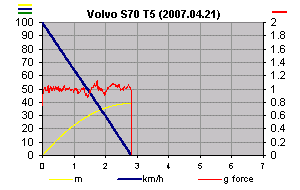
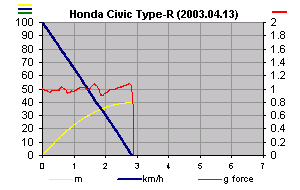
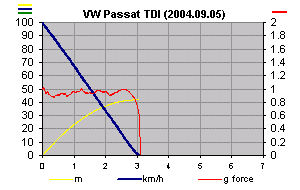
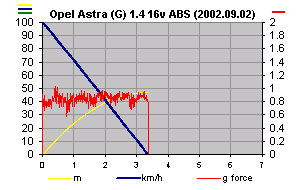
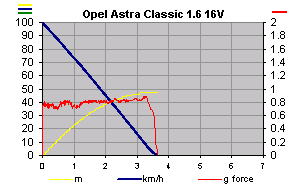
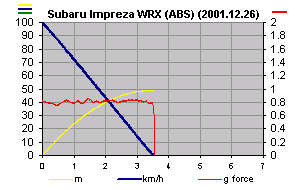
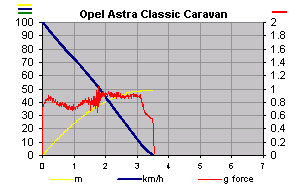
.gif)
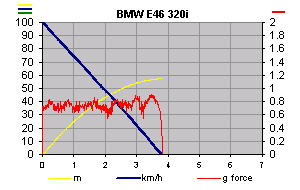
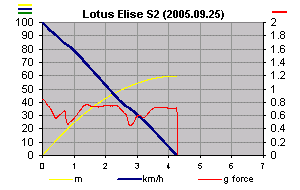
.gif)
